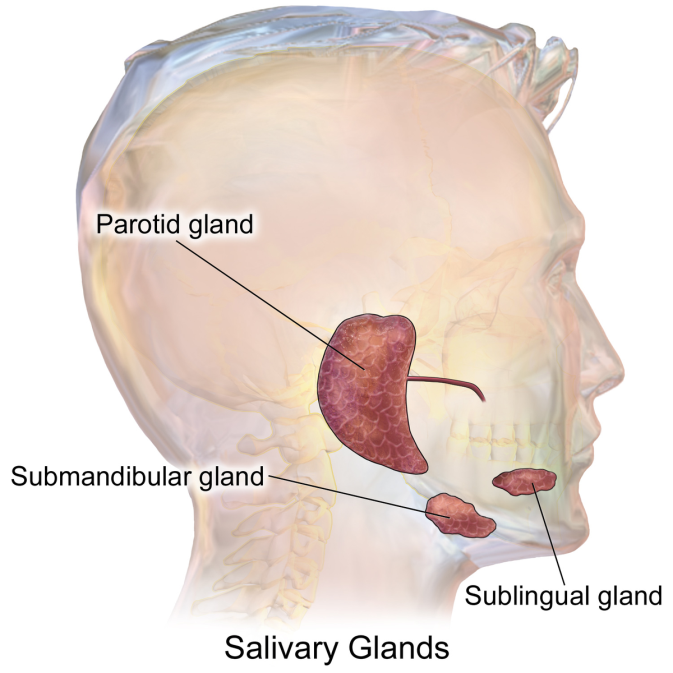
A digestive enzyme salivary amylase (present in saliva) begins digestion of
A. Protein
B. Nucleic acids
C. Fats
D. Carbohydrates
Answer
487.2k+ views
Hint: The food after chewing for some time feels sweet because of the presence of salivary amylase enzymes in the mouth which start the digestion of the food.
Complete answer:
The correct answer is (D).
The salivary glands are present in the buccal cavity/ mouth which secrete the saliva and the carbohydrate digesting enzyme called salivary amylase. The saliva is responsible for mixing up the food and thus lubricates it to make its further movement easier in the alimentary canal whereas the enzyme salivary amylase starts the digestion of carbohydrates by breaking them and converting into a disaccharide called maltose. The hydrolytic activity of this carbohydrate breaking enzyme takes place at pH of about 6.8. This enzyme is responsible for hydrolyzing around 30 percent of the starch.

This hydrolyzed starch is further passed on to the esophagus and through peristaltic movements, it finally reaches the small intestine via the stomach where further digestion of carbohydrates takes place and it gets converted into the simpler units (monosaccharide) called glucose.
Salivary glands along with saliva and salivary amylase also secrete another enzyme called lysozyme, which have antibacterial properties.
There are three types of salivary glands present in the mouth-
- Parotid gland which are present in the cheeks,
- Submandibular glands which are present in the lower jaws; and
- Sublingual glands which are present below the tongue.
Note: The salivary glands are present in the buccal cavity and are responsible only for the digestion of the carbohydrates. Digestion of other components of food like fats, proteins etc. starts at other specific sites.
Complete answer:
The correct answer is (D).
The salivary glands are present in the buccal cavity/ mouth which secrete the saliva and the carbohydrate digesting enzyme called salivary amylase. The saliva is responsible for mixing up the food and thus lubricates it to make its further movement easier in the alimentary canal whereas the enzyme salivary amylase starts the digestion of carbohydrates by breaking them and converting into a disaccharide called maltose. The hydrolytic activity of this carbohydrate breaking enzyme takes place at pH of about 6.8. This enzyme is responsible for hydrolyzing around 30 percent of the starch.

This hydrolyzed starch is further passed on to the esophagus and through peristaltic movements, it finally reaches the small intestine via the stomach where further digestion of carbohydrates takes place and it gets converted into the simpler units (monosaccharide) called glucose.
Salivary glands along with saliva and salivary amylase also secrete another enzyme called lysozyme, which have antibacterial properties.
There are three types of salivary glands present in the mouth-
- Parotid gland which are present in the cheeks,
- Submandibular glands which are present in the lower jaws; and
- Sublingual glands which are present below the tongue.
Note: The salivary glands are present in the buccal cavity and are responsible only for the digestion of the carbohydrates. Digestion of other components of food like fats, proteins etc. starts at other specific sites.
Recently Updated Pages
Full Form of IASDMIPSIFSIRSPOLICE class 7 social science CBSE

In case of conflict between fundamental rights of citizens class 7 social science CBSE

Can anyone list 10 advantages and disadvantages of friction

What are the Components of Financial System?

Complete the letter given below written to your Principal class null english null

Express the following as a fraction and simplify a class 7 maths CBSE

Trending doubts
Who was Subhash Chandra Bose Why was he called Net class 10 english CBSE

Saptarishi is the Indian name of which Constellation class 10 social science CBSE

Complete the sentence with the most appropriate word class 10 english CBSE

Fill the blanks with proper collective nouns 1 A of class 10 english CBSE

List out three methods of soil conservation

Who is the executive head of the government APresident class 10 social science CBSE




